Planned Behaviour Therapy and Alcohol Consumption: A Research Report
VerifiedAdded on 2021/06/16
|10
|2448
|51
Report
AI Summary
This report investigates the correlation between planned behaviour therapy and alcohol consumption, exploring how attitudes, subjective norms, and perceived behavioural control influence drinking intentions. The study examines specific research questions, including whether these factors are related to alcohol use and whether there are differences between males and females. Results from descriptive and inferential statistics, including correlations and t-tests, are presented. The findings indicate a positive relationship between intentions to use alcohol and attitudes, subjective norms, and perceived behavioural control. The study also found no significant correlation between intentions to use alcohol and depression, anxiety, and stress levels. Furthermore, the study revealed significant differences in attitudes, subjective norms, and perceived behavioural control between males and females, indicating varied influences on alcohol consumption across genders. The report concludes by discussing the implications of these findings and referencing relevant literature.
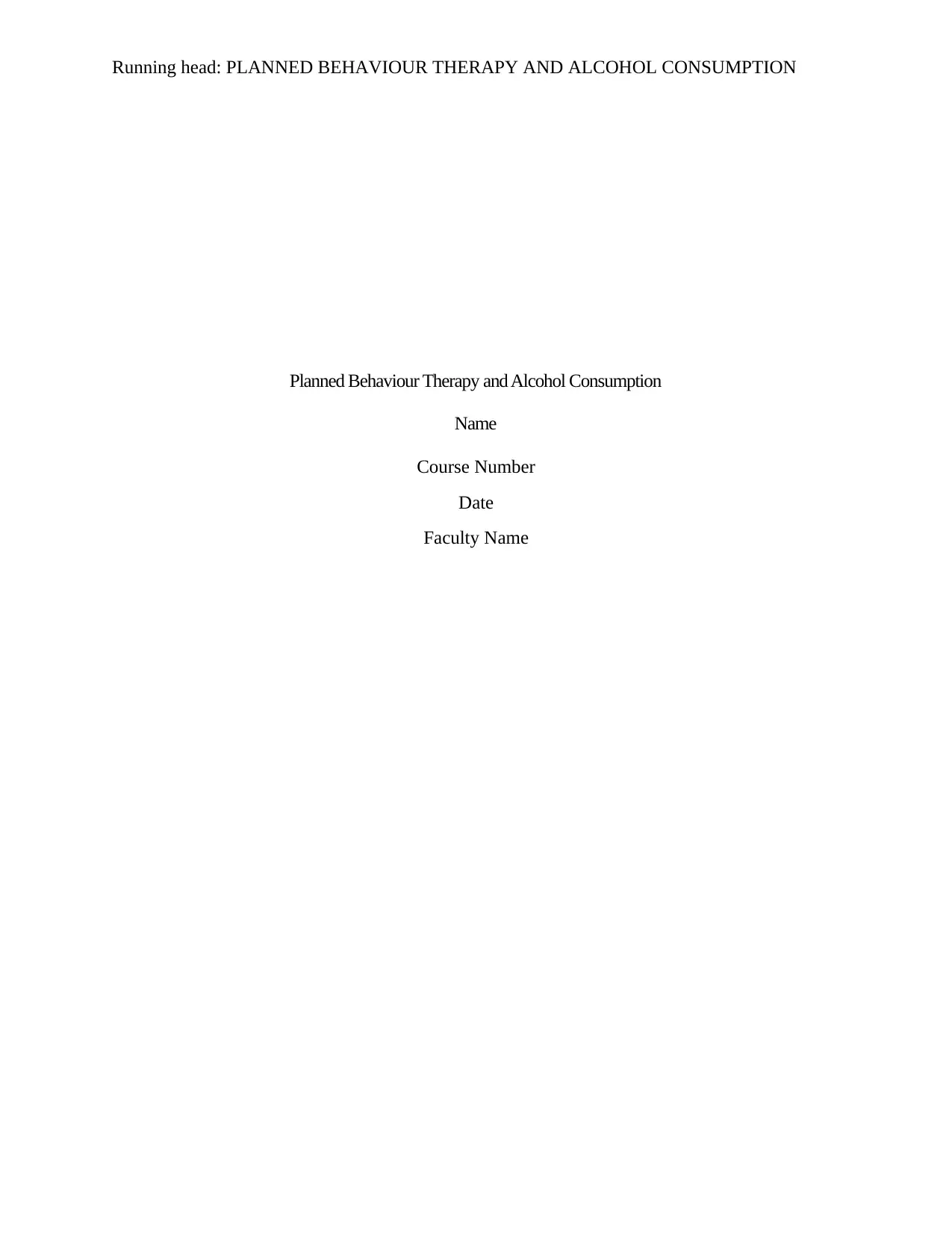
Running head: PLANNED BEHAVIOUR THERAPY AND ALCOHOL CONSUMPTION
Planned Behaviour Therapy and Alcohol Consumption
Name
Course Number
Date
Faculty Name
Planned Behaviour Therapy and Alcohol Consumption
Name
Course Number
Date
Faculty Name
Paraphrase This Document
Need a fresh take? Get an instant paraphrase of this document with our AI Paraphraser

PLANNED BEHAVIOUR THERAPY AND ALCOHOL CONSUMPTION 2
Planned Behaviour Therapy and Alcohol Consumption
Introduction
Alcohol consumption is among the main risk factors of non-communicable disease and
health conditions. Therefore, it is a main public health research which has ignited a lot of
research to understand reasons behind people drinking and possible ways of controlling binge
drinking. Several researchers have developed effective theories on alcohol consumption which
has been of great importance and assistance in advising alcoholics and young adults to reduce
levels of drinking. It has been identified that there are social, psychological, economic and
environmental factors affect the decision of an individual, hence changes in their behaviours.
This indicates that the behaviours of a person can change based on their current financial status,
their places of residents, people they interact with, places of work among other factors. Past
experiences can also be used to shape a person’s future on alcohol consumption – which might
be misused for both chronic and acute use. For instance, an individual who has been brought up a
family where the parents were drunkards have a higher risk of being an alcohol user as compared
to a person whose parents do not take alcohol.
Despite the environmental, economic and environmental factors affecting the intentions
and willingness to take alcohol, human behaviour takes a critical role in influencing the decision
of a person. Just as the human behaviour has been used to predict health outcomes, in the same
way, it can be used to determine alcohol consumption levels and intentions. Further, Ajzen
(1991), argued that human behaviour is majorly determined by the willingness and intentions to
perform a certain behaviour. As a result of a combination of motivation, differences in
personalities and upbringing, human behaviour differs significantly based on these variations.
Three factors have been identified as the determinants of intention, which include subjective
Planned Behaviour Therapy and Alcohol Consumption
Introduction
Alcohol consumption is among the main risk factors of non-communicable disease and
health conditions. Therefore, it is a main public health research which has ignited a lot of
research to understand reasons behind people drinking and possible ways of controlling binge
drinking. Several researchers have developed effective theories on alcohol consumption which
has been of great importance and assistance in advising alcoholics and young adults to reduce
levels of drinking. It has been identified that there are social, psychological, economic and
environmental factors affect the decision of an individual, hence changes in their behaviours.
This indicates that the behaviours of a person can change based on their current financial status,
their places of residents, people they interact with, places of work among other factors. Past
experiences can also be used to shape a person’s future on alcohol consumption – which might
be misused for both chronic and acute use. For instance, an individual who has been brought up a
family where the parents were drunkards have a higher risk of being an alcohol user as compared
to a person whose parents do not take alcohol.
Despite the environmental, economic and environmental factors affecting the intentions
and willingness to take alcohol, human behaviour takes a critical role in influencing the decision
of a person. Just as the human behaviour has been used to predict health outcomes, in the same
way, it can be used to determine alcohol consumption levels and intentions. Further, Ajzen
(1991), argued that human behaviour is majorly determined by the willingness and intentions to
perform a certain behaviour. As a result of a combination of motivation, differences in
personalities and upbringing, human behaviour differs significantly based on these variations.
Three factors have been identified as the determinants of intention, which include subjective
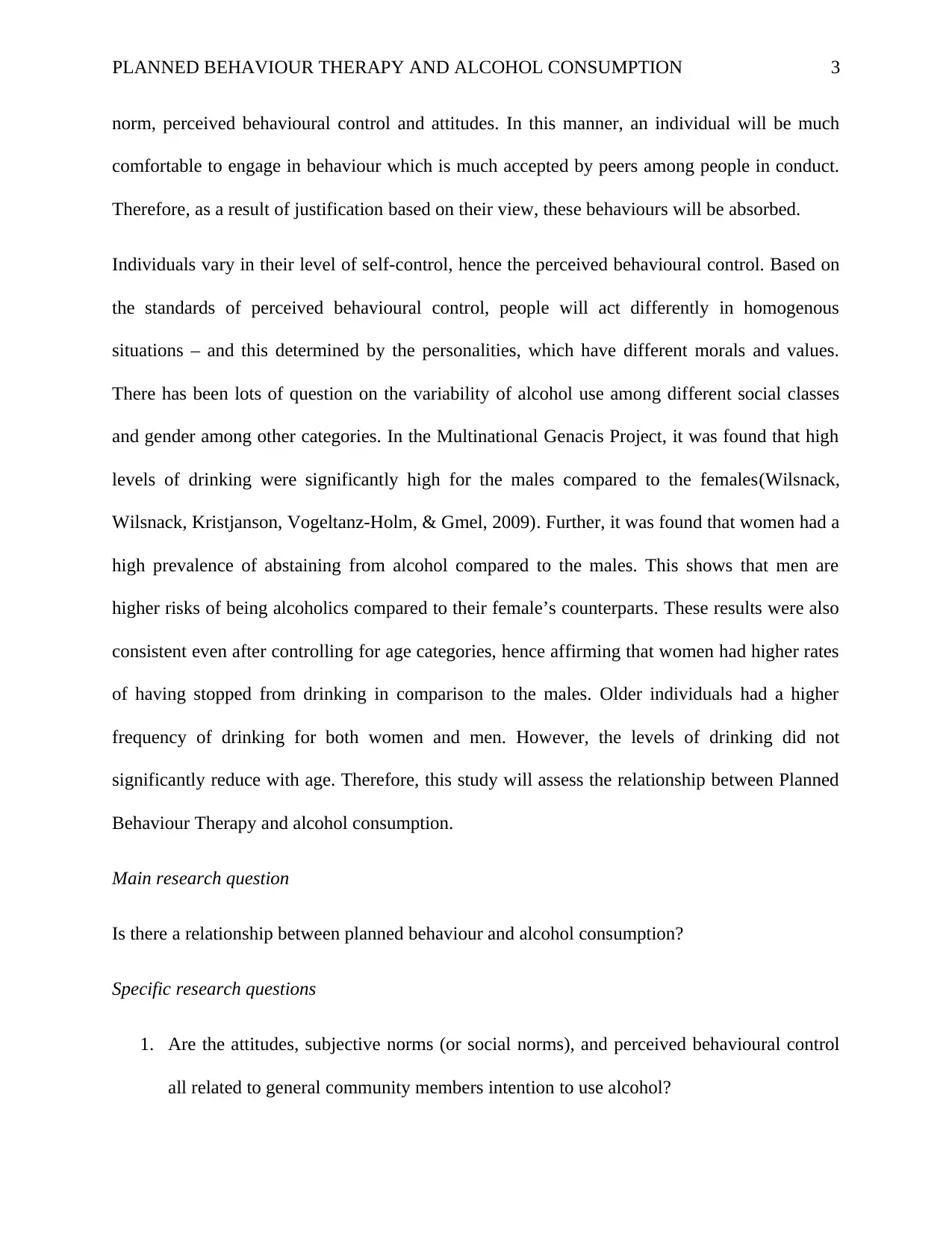
PLANNED BEHAVIOUR THERAPY AND ALCOHOL CONSUMPTION 3
norm, perceived behavioural control and attitudes. In this manner, an individual will be much
comfortable to engage in behaviour which is much accepted by peers among people in conduct.
Therefore, as a result of justification based on their view, these behaviours will be absorbed.
Individuals vary in their level of self-control, hence the perceived behavioural control. Based on
the standards of perceived behavioural control, people will act differently in homogenous
situations – and this determined by the personalities, which have different morals and values.
There has been lots of question on the variability of alcohol use among different social classes
and gender among other categories. In the Multinational Genacis Project, it was found that high
levels of drinking were significantly high for the males compared to the females(Wilsnack,
Wilsnack, Kristjanson, Vogeltanz-Holm, & Gmel, 2009). Further, it was found that women had a
high prevalence of abstaining from alcohol compared to the males. This shows that men are
higher risks of being alcoholics compared to their female’s counterparts. These results were also
consistent even after controlling for age categories, hence affirming that women had higher rates
of having stopped from drinking in comparison to the males. Older individuals had a higher
frequency of drinking for both women and men. However, the levels of drinking did not
significantly reduce with age. Therefore, this study will assess the relationship between Planned
Behaviour Therapy and alcohol consumption.
Main research question
Is there a relationship between planned behaviour and alcohol consumption?
Specific research questions
1. Are the attitudes, subjective norms (or social norms), and perceived behavioural control
all related to general community members intention to use alcohol?
norm, perceived behavioural control and attitudes. In this manner, an individual will be much
comfortable to engage in behaviour which is much accepted by peers among people in conduct.
Therefore, as a result of justification based on their view, these behaviours will be absorbed.
Individuals vary in their level of self-control, hence the perceived behavioural control. Based on
the standards of perceived behavioural control, people will act differently in homogenous
situations – and this determined by the personalities, which have different morals and values.
There has been lots of question on the variability of alcohol use among different social classes
and gender among other categories. In the Multinational Genacis Project, it was found that high
levels of drinking were significantly high for the males compared to the females(Wilsnack,
Wilsnack, Kristjanson, Vogeltanz-Holm, & Gmel, 2009). Further, it was found that women had a
high prevalence of abstaining from alcohol compared to the males. This shows that men are
higher risks of being alcoholics compared to their female’s counterparts. These results were also
consistent even after controlling for age categories, hence affirming that women had higher rates
of having stopped from drinking in comparison to the males. Older individuals had a higher
frequency of drinking for both women and men. However, the levels of drinking did not
significantly reduce with age. Therefore, this study will assess the relationship between Planned
Behaviour Therapy and alcohol consumption.
Main research question
Is there a relationship between planned behaviour and alcohol consumption?
Specific research questions
1. Are the attitudes, subjective norms (or social norms), and perceived behavioural control
all related to general community members intention to use alcohol?
⊘ This is a preview!⊘
Do you want full access?
Subscribe today to unlock all pages.

Trusted by 1+ million students worldwide
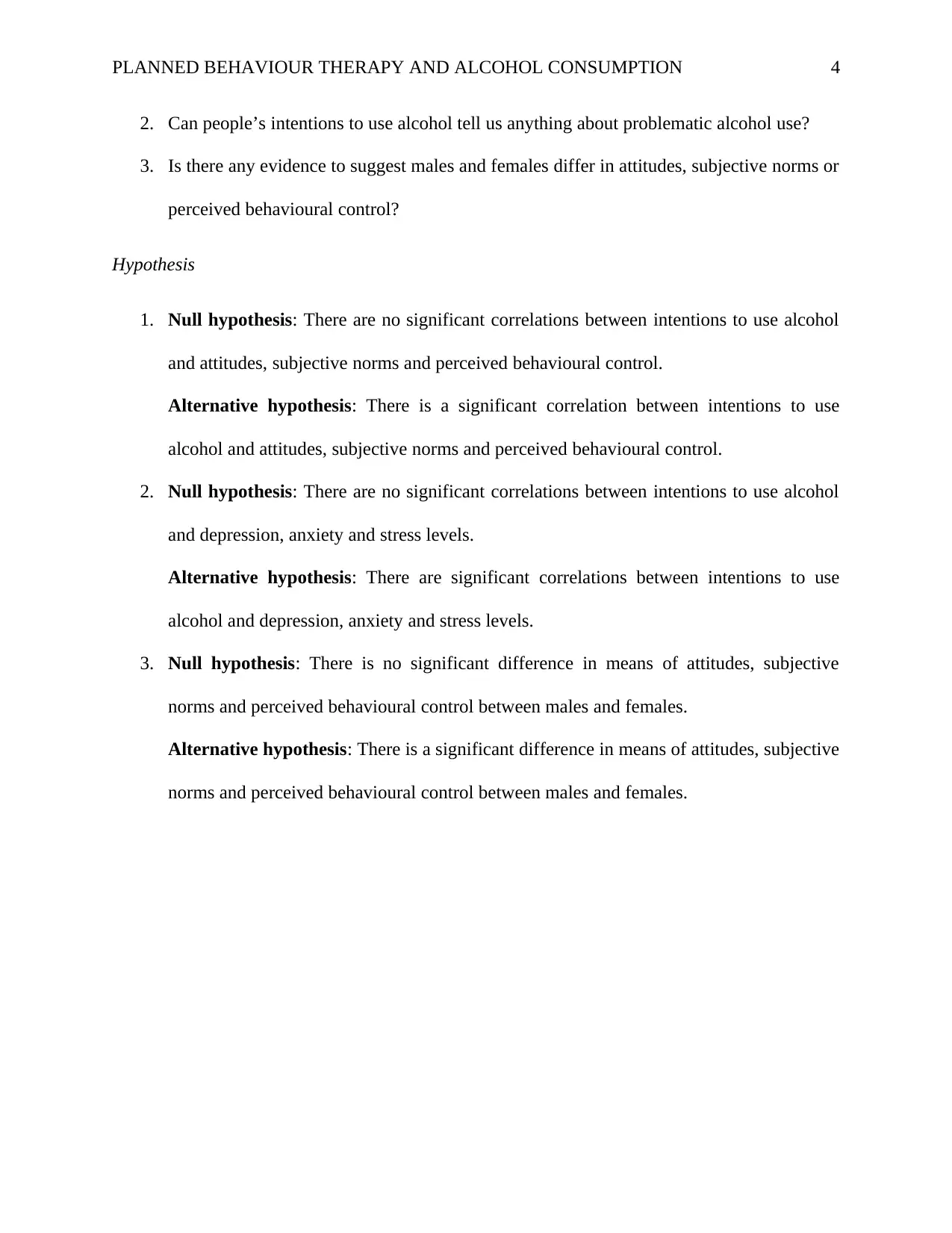
PLANNED BEHAVIOUR THERAPY AND ALCOHOL CONSUMPTION 4
2. Can people’s intentions to use alcohol tell us anything about problematic alcohol use?
3. Is there any evidence to suggest males and females differ in attitudes, subjective norms or
perceived behavioural control?
Hypothesis
1. Null hypothesis: There are no significant correlations between intentions to use alcohol
and attitudes, subjective norms and perceived behavioural control.
Alternative hypothesis: There is a significant correlation between intentions to use
alcohol and attitudes, subjective norms and perceived behavioural control.
2. Null hypothesis: There are no significant correlations between intentions to use alcohol
and depression, anxiety and stress levels.
Alternative hypothesis: There are significant correlations between intentions to use
alcohol and depression, anxiety and stress levels.
3. Null hypothesis: There is no significant difference in means of attitudes, subjective
norms and perceived behavioural control between males and females.
Alternative hypothesis: There is a significant difference in means of attitudes, subjective
norms and perceived behavioural control between males and females.
2. Can people’s intentions to use alcohol tell us anything about problematic alcohol use?
3. Is there any evidence to suggest males and females differ in attitudes, subjective norms or
perceived behavioural control?
Hypothesis
1. Null hypothesis: There are no significant correlations between intentions to use alcohol
and attitudes, subjective norms and perceived behavioural control.
Alternative hypothesis: There is a significant correlation between intentions to use
alcohol and attitudes, subjective norms and perceived behavioural control.
2. Null hypothesis: There are no significant correlations between intentions to use alcohol
and depression, anxiety and stress levels.
Alternative hypothesis: There are significant correlations between intentions to use
alcohol and depression, anxiety and stress levels.
3. Null hypothesis: There is no significant difference in means of attitudes, subjective
norms and perceived behavioural control between males and females.
Alternative hypothesis: There is a significant difference in means of attitudes, subjective
norms and perceived behavioural control between males and females.
Paraphrase This Document
Need a fresh take? Get an instant paraphrase of this document with our AI Paraphraser
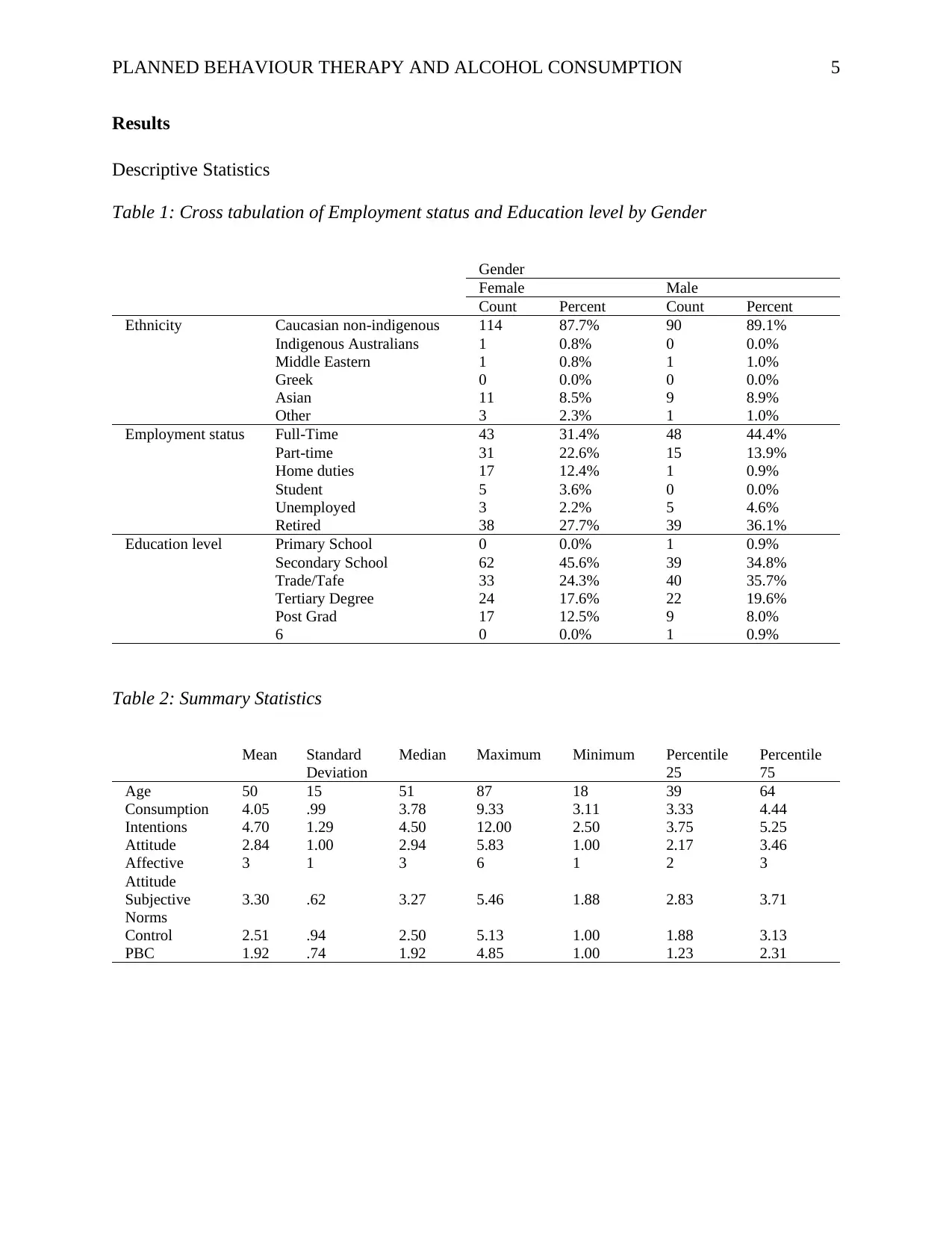
PLANNED BEHAVIOUR THERAPY AND ALCOHOL CONSUMPTION 5
Results
Descriptive Statistics
Table 1: Cross tabulation of Employment status and Education level by Gender
Gender
Female Male
Count Percent Count Percent
Ethnicity Caucasian non-indigenous 114 87.7% 90 89.1%
Indigenous Australians 1 0.8% 0 0.0%
Middle Eastern 1 0.8% 1 1.0%
Greek 0 0.0% 0 0.0%
Asian 11 8.5% 9 8.9%
Other 3 2.3% 1 1.0%
Employment status Full-Time 43 31.4% 48 44.4%
Part-time 31 22.6% 15 13.9%
Home duties 17 12.4% 1 0.9%
Student 5 3.6% 0 0.0%
Unemployed 3 2.2% 5 4.6%
Retired 38 27.7% 39 36.1%
Education level Primary School 0 0.0% 1 0.9%
Secondary School 62 45.6% 39 34.8%
Trade/Tafe 33 24.3% 40 35.7%
Tertiary Degree 24 17.6% 22 19.6%
Post Grad 17 12.5% 9 8.0%
6 0 0.0% 1 0.9%
Table 2: Summary Statistics
Mean Standard
Deviation
Median Maximum Minimum Percentile
25
Percentile
75
Age 50 15 51 87 18 39 64
Consumption 4.05 .99 3.78 9.33 3.11 3.33 4.44
Intentions 4.70 1.29 4.50 12.00 2.50 3.75 5.25
Attitude 2.84 1.00 2.94 5.83 1.00 2.17 3.46
Affective
Attitude
3 1 3 6 1 2 3
Subjective
Norms
3.30 .62 3.27 5.46 1.88 2.83 3.71
Control 2.51 .94 2.50 5.13 1.00 1.88 3.13
PBC 1.92 .74 1.92 4.85 1.00 1.23 2.31
Results
Descriptive Statistics
Table 1: Cross tabulation of Employment status and Education level by Gender
Gender
Female Male
Count Percent Count Percent
Ethnicity Caucasian non-indigenous 114 87.7% 90 89.1%
Indigenous Australians 1 0.8% 0 0.0%
Middle Eastern 1 0.8% 1 1.0%
Greek 0 0.0% 0 0.0%
Asian 11 8.5% 9 8.9%
Other 3 2.3% 1 1.0%
Employment status Full-Time 43 31.4% 48 44.4%
Part-time 31 22.6% 15 13.9%
Home duties 17 12.4% 1 0.9%
Student 5 3.6% 0 0.0%
Unemployed 3 2.2% 5 4.6%
Retired 38 27.7% 39 36.1%
Education level Primary School 0 0.0% 1 0.9%
Secondary School 62 45.6% 39 34.8%
Trade/Tafe 33 24.3% 40 35.7%
Tertiary Degree 24 17.6% 22 19.6%
Post Grad 17 12.5% 9 8.0%
6 0 0.0% 1 0.9%
Table 2: Summary Statistics
Mean Standard
Deviation
Median Maximum Minimum Percentile
25
Percentile
75
Age 50 15 51 87 18 39 64
Consumption 4.05 .99 3.78 9.33 3.11 3.33 4.44
Intentions 4.70 1.29 4.50 12.00 2.50 3.75 5.25
Attitude 2.84 1.00 2.94 5.83 1.00 2.17 3.46
Affective
Attitude
3 1 3 6 1 2 3
Subjective
Norms
3.30 .62 3.27 5.46 1.88 2.83 3.71
Control 2.51 .94 2.50 5.13 1.00 1.88 3.13
PBC 1.92 .74 1.92 4.85 1.00 1.23 2.31
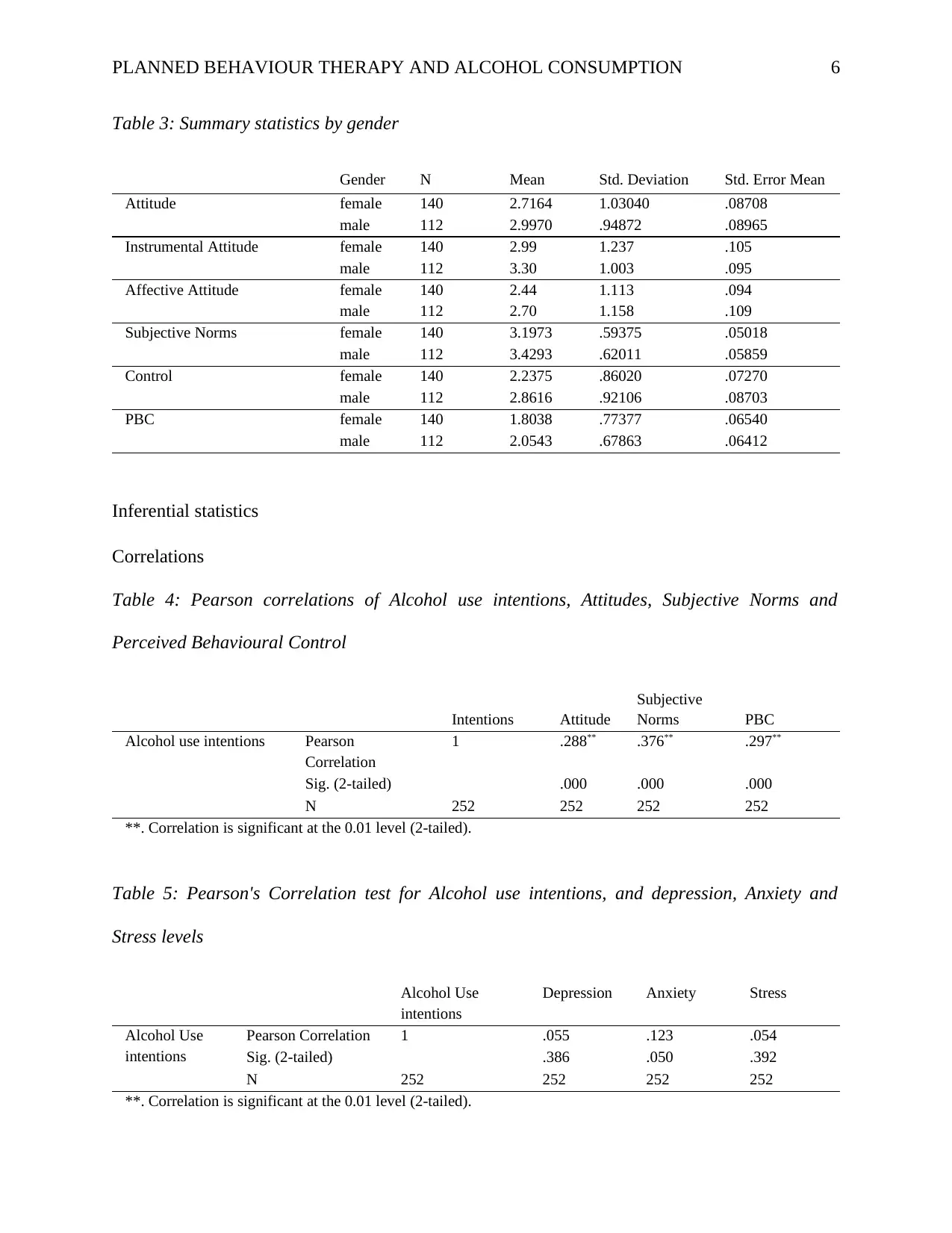
PLANNED BEHAVIOUR THERAPY AND ALCOHOL CONSUMPTION 6
Table 3: Summary statistics by gender
Gender N Mean Std. Deviation Std. Error Mean
Attitude female 140 2.7164 1.03040 .08708
male 112 2.9970 .94872 .08965
Instrumental Attitude female 140 2.99 1.237 .105
male 112 3.30 1.003 .095
Affective Attitude female 140 2.44 1.113 .094
male 112 2.70 1.158 .109
Subjective Norms female 140 3.1973 .59375 .05018
male 112 3.4293 .62011 .05859
Control female 140 2.2375 .86020 .07270
male 112 2.8616 .92106 .08703
PBC female 140 1.8038 .77377 .06540
male 112 2.0543 .67863 .06412
Inferential statistics
Correlations
Table 4: Pearson correlations of Alcohol use intentions, Attitudes, Subjective Norms and
Perceived Behavioural Control
Intentions Attitude
Subjective
Norms PBC
Alcohol use intentions Pearson
Correlation
1 .288** .376** .297**
Sig. (2-tailed) .000 .000 .000
N 252 252 252 252
**. Correlation is significant at the 0.01 level (2-tailed).
Table 5: Pearson's Correlation test for Alcohol use intentions, and depression, Anxiety and
Stress levels
Alcohol Use
intentions
Depression Anxiety Stress
Alcohol Use
intentions
Pearson Correlation 1 .055 .123 .054
Sig. (2-tailed) .386 .050 .392
N 252 252 252 252
**. Correlation is significant at the 0.01 level (2-tailed).
Table 3: Summary statistics by gender
Gender N Mean Std. Deviation Std. Error Mean
Attitude female 140 2.7164 1.03040 .08708
male 112 2.9970 .94872 .08965
Instrumental Attitude female 140 2.99 1.237 .105
male 112 3.30 1.003 .095
Affective Attitude female 140 2.44 1.113 .094
male 112 2.70 1.158 .109
Subjective Norms female 140 3.1973 .59375 .05018
male 112 3.4293 .62011 .05859
Control female 140 2.2375 .86020 .07270
male 112 2.8616 .92106 .08703
PBC female 140 1.8038 .77377 .06540
male 112 2.0543 .67863 .06412
Inferential statistics
Correlations
Table 4: Pearson correlations of Alcohol use intentions, Attitudes, Subjective Norms and
Perceived Behavioural Control
Intentions Attitude
Subjective
Norms PBC
Alcohol use intentions Pearson
Correlation
1 .288** .376** .297**
Sig. (2-tailed) .000 .000 .000
N 252 252 252 252
**. Correlation is significant at the 0.01 level (2-tailed).
Table 5: Pearson's Correlation test for Alcohol use intentions, and depression, Anxiety and
Stress levels
Alcohol Use
intentions
Depression Anxiety Stress
Alcohol Use
intentions
Pearson Correlation 1 .055 .123 .054
Sig. (2-tailed) .386 .050 .392
N 252 252 252 252
**. Correlation is significant at the 0.01 level (2-tailed).
⊘ This is a preview!⊘
Do you want full access?
Subscribe today to unlock all pages.

Trusted by 1+ million students worldwide
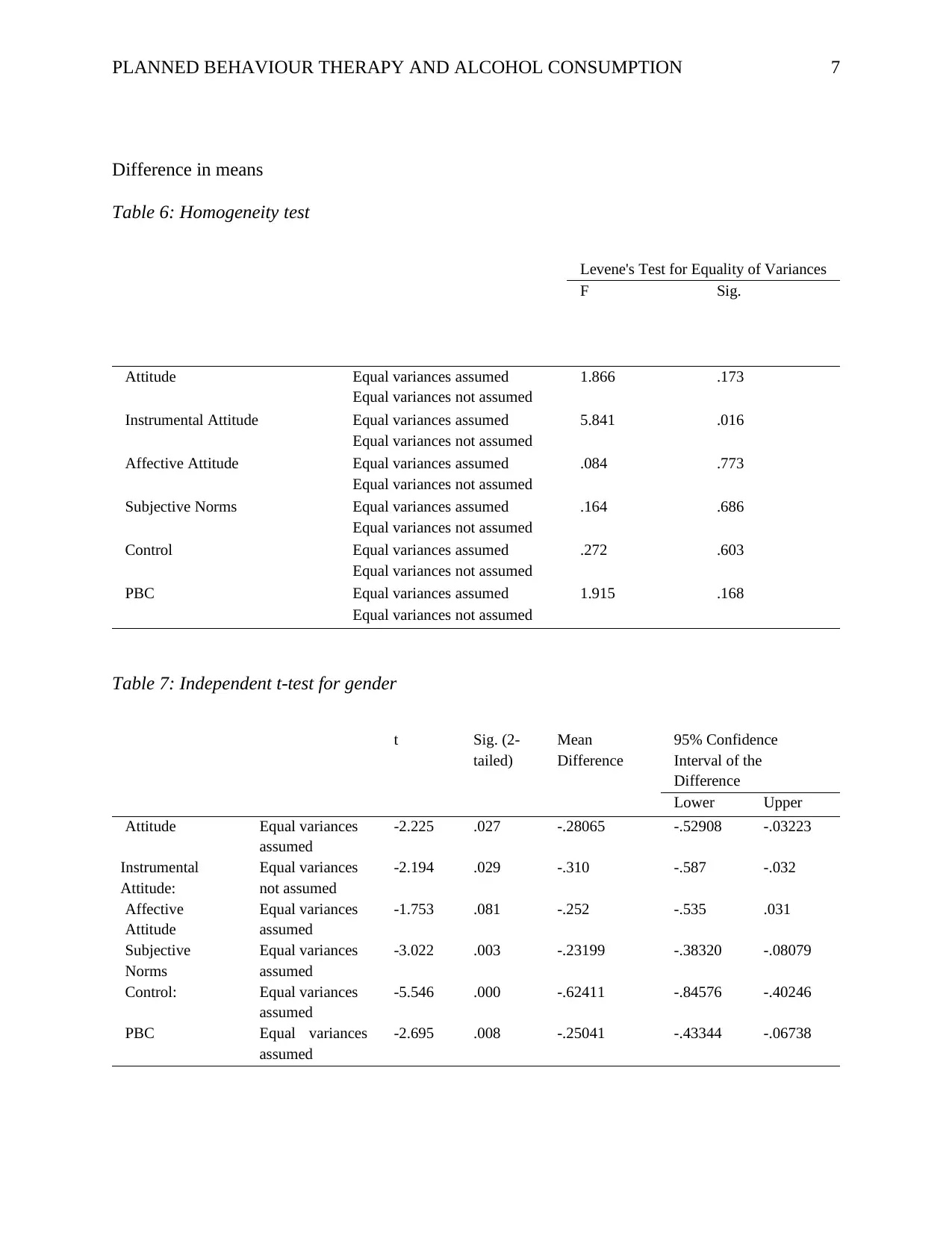
PLANNED BEHAVIOUR THERAPY AND ALCOHOL CONSUMPTION 7
Difference in means
Table 6: Homogeneity test
Levene's Test for Equality of Variances
F Sig.
Attitude Equal variances assumed 1.866 .173
Equal variances not assumed
Instrumental Attitude Equal variances assumed 5.841 .016
Equal variances not assumed
Affective Attitude Equal variances assumed .084 .773
Equal variances not assumed
Subjective Norms Equal variances assumed .164 .686
Equal variances not assumed
Control Equal variances assumed .272 .603
Equal variances not assumed
PBC Equal variances assumed 1.915 .168
Equal variances not assumed
Table 7: Independent t-test for gender
t Sig. (2-
tailed)
Mean
Difference
95% Confidence
Interval of the
Difference
Lower Upper
Attitude Equal variances
assumed
-2.225 .027 -.28065 -.52908 -.03223
Instrumental
Attitude:
Equal variances
not assumed
-2.194 .029 -.310 -.587 -.032
Affective
Attitude
Equal variances
assumed
-1.753 .081 -.252 -.535 .031
Subjective
Norms
Equal variances
assumed
-3.022 .003 -.23199 -.38320 -.08079
Control: Equal variances
assumed
-5.546 .000 -.62411 -.84576 -.40246
PBC Equal variances
assumed
-2.695 .008 -.25041 -.43344 -.06738
Difference in means
Table 6: Homogeneity test
Levene's Test for Equality of Variances
F Sig.
Attitude Equal variances assumed 1.866 .173
Equal variances not assumed
Instrumental Attitude Equal variances assumed 5.841 .016
Equal variances not assumed
Affective Attitude Equal variances assumed .084 .773
Equal variances not assumed
Subjective Norms Equal variances assumed .164 .686
Equal variances not assumed
Control Equal variances assumed .272 .603
Equal variances not assumed
PBC Equal variances assumed 1.915 .168
Equal variances not assumed
Table 7: Independent t-test for gender
t Sig. (2-
tailed)
Mean
Difference
95% Confidence
Interval of the
Difference
Lower Upper
Attitude Equal variances
assumed
-2.225 .027 -.28065 -.52908 -.03223
Instrumental
Attitude:
Equal variances
not assumed
-2.194 .029 -.310 -.587 -.032
Affective
Attitude
Equal variances
assumed
-1.753 .081 -.252 -.535 .031
Subjective
Norms
Equal variances
assumed
-3.022 .003 -.23199 -.38320 -.08079
Control: Equal variances
assumed
-5.546 .000 -.62411 -.84576 -.40246
PBC Equal variances
assumed
-2.695 .008 -.25041 -.43344 -.06738
Paraphrase This Document
Need a fresh take? Get an instant paraphrase of this document with our AI Paraphraser
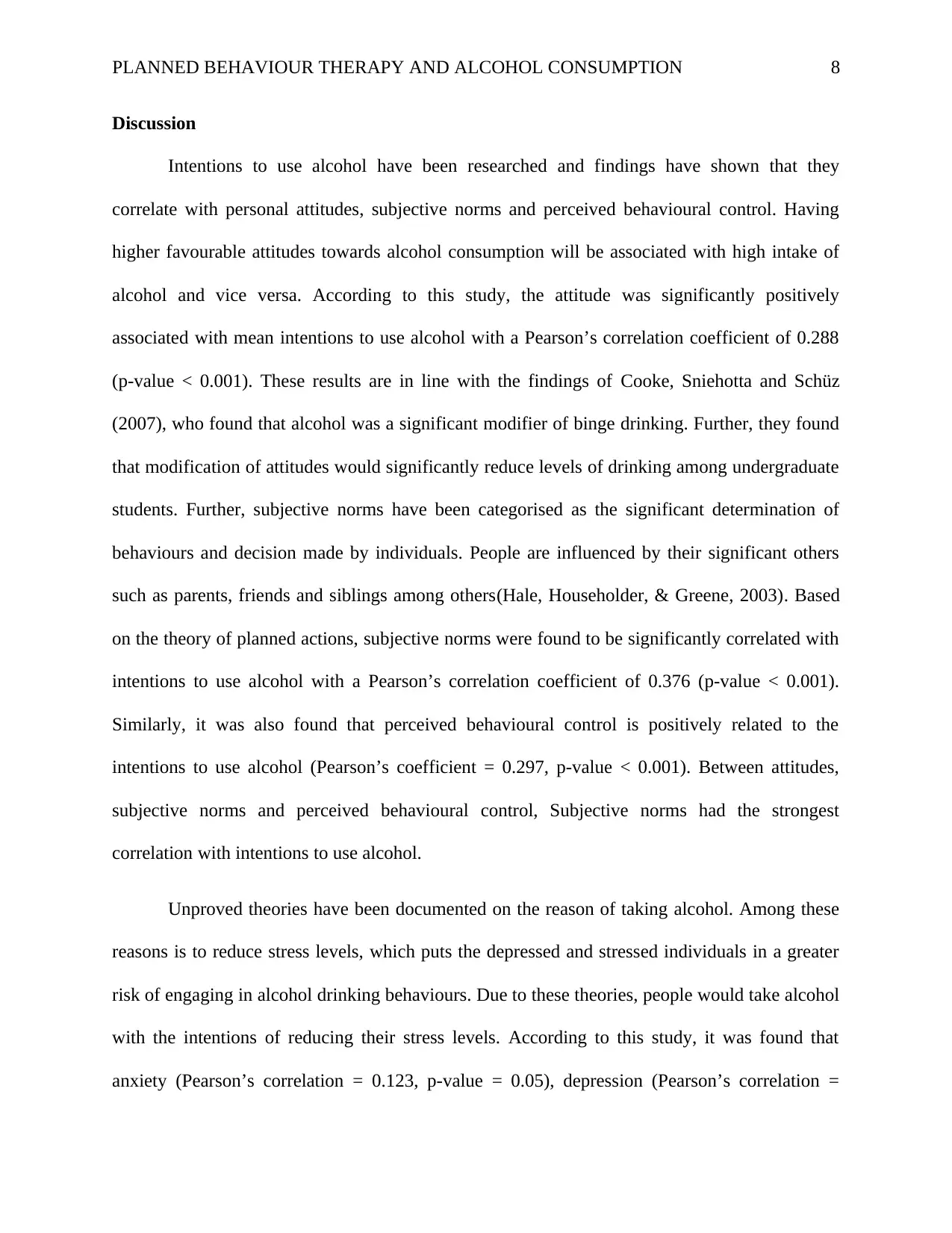
PLANNED BEHAVIOUR THERAPY AND ALCOHOL CONSUMPTION 8
Discussion
Intentions to use alcohol have been researched and findings have shown that they
correlate with personal attitudes, subjective norms and perceived behavioural control. Having
higher favourable attitudes towards alcohol consumption will be associated with high intake of
alcohol and vice versa. According to this study, the attitude was significantly positively
associated with mean intentions to use alcohol with a Pearson’s correlation coefficient of 0.288
(p-value < 0.001). These results are in line with the findings of Cooke, Sniehotta and Schüz
(2007), who found that alcohol was a significant modifier of binge drinking. Further, they found
that modification of attitudes would significantly reduce levels of drinking among undergraduate
students. Further, subjective norms have been categorised as the significant determination of
behaviours and decision made by individuals. People are influenced by their significant others
such as parents, friends and siblings among others(Hale, Householder, & Greene, 2003). Based
on the theory of planned actions, subjective norms were found to be significantly correlated with
intentions to use alcohol with a Pearson’s correlation coefficient of 0.376 (p-value < 0.001).
Similarly, it was also found that perceived behavioural control is positively related to the
intentions to use alcohol (Pearson’s coefficient = 0.297, p-value < 0.001). Between attitudes,
subjective norms and perceived behavioural control, Subjective norms had the strongest
correlation with intentions to use alcohol.
Unproved theories have been documented on the reason of taking alcohol. Among these
reasons is to reduce stress levels, which puts the depressed and stressed individuals in a greater
risk of engaging in alcohol drinking behaviours. Due to these theories, people would take alcohol
with the intentions of reducing their stress levels. According to this study, it was found that
anxiety (Pearson’s correlation = 0.123, p-value = 0.05), depression (Pearson’s correlation =
Discussion
Intentions to use alcohol have been researched and findings have shown that they
correlate with personal attitudes, subjective norms and perceived behavioural control. Having
higher favourable attitudes towards alcohol consumption will be associated with high intake of
alcohol and vice versa. According to this study, the attitude was significantly positively
associated with mean intentions to use alcohol with a Pearson’s correlation coefficient of 0.288
(p-value < 0.001). These results are in line with the findings of Cooke, Sniehotta and Schüz
(2007), who found that alcohol was a significant modifier of binge drinking. Further, they found
that modification of attitudes would significantly reduce levels of drinking among undergraduate
students. Further, subjective norms have been categorised as the significant determination of
behaviours and decision made by individuals. People are influenced by their significant others
such as parents, friends and siblings among others(Hale, Householder, & Greene, 2003). Based
on the theory of planned actions, subjective norms were found to be significantly correlated with
intentions to use alcohol with a Pearson’s correlation coefficient of 0.376 (p-value < 0.001).
Similarly, it was also found that perceived behavioural control is positively related to the
intentions to use alcohol (Pearson’s coefficient = 0.297, p-value < 0.001). Between attitudes,
subjective norms and perceived behavioural control, Subjective norms had the strongest
correlation with intentions to use alcohol.
Unproved theories have been documented on the reason of taking alcohol. Among these
reasons is to reduce stress levels, which puts the depressed and stressed individuals in a greater
risk of engaging in alcohol drinking behaviours. Due to these theories, people would take alcohol
with the intentions of reducing their stress levels. According to this study, it was found that
anxiety (Pearson’s correlation = 0.123, p-value = 0.05), depression (Pearson’s correlation =
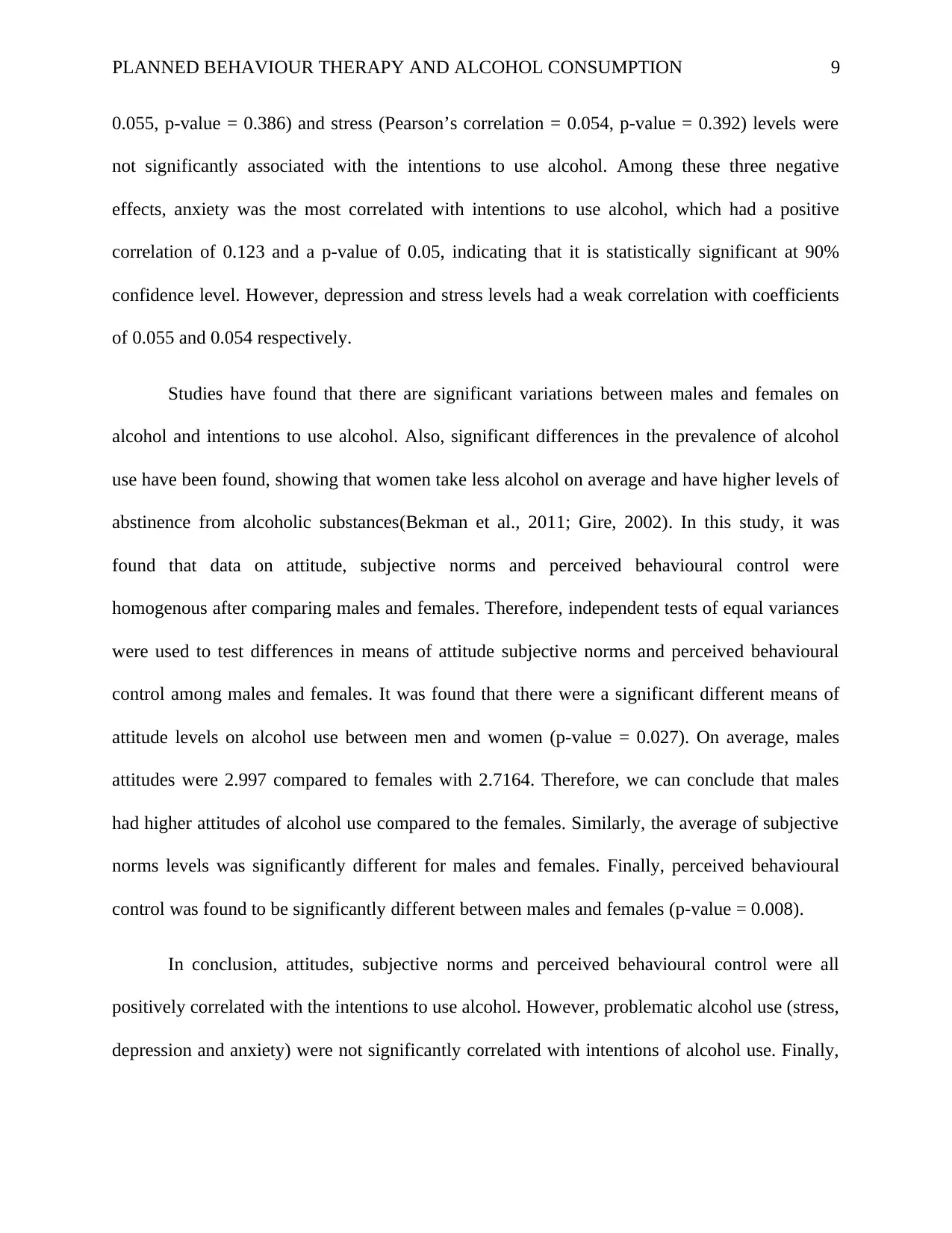
PLANNED BEHAVIOUR THERAPY AND ALCOHOL CONSUMPTION 9
0.055, p-value = 0.386) and stress (Pearson’s correlation = 0.054, p-value = 0.392) levels were
not significantly associated with the intentions to use alcohol. Among these three negative
effects, anxiety was the most correlated with intentions to use alcohol, which had a positive
correlation of 0.123 and a p-value of 0.05, indicating that it is statistically significant at 90%
confidence level. However, depression and stress levels had a weak correlation with coefficients
of 0.055 and 0.054 respectively.
Studies have found that there are significant variations between males and females on
alcohol and intentions to use alcohol. Also, significant differences in the prevalence of alcohol
use have been found, showing that women take less alcohol on average and have higher levels of
abstinence from alcoholic substances(Bekman et al., 2011; Gire, 2002). In this study, it was
found that data on attitude, subjective norms and perceived behavioural control were
homogenous after comparing males and females. Therefore, independent tests of equal variances
were used to test differences in means of attitude subjective norms and perceived behavioural
control among males and females. It was found that there were a significant different means of
attitude levels on alcohol use between men and women (p-value = 0.027). On average, males
attitudes were 2.997 compared to females with 2.7164. Therefore, we can conclude that males
had higher attitudes of alcohol use compared to the females. Similarly, the average of subjective
norms levels was significantly different for males and females. Finally, perceived behavioural
control was found to be significantly different between males and females (p-value = 0.008).
In conclusion, attitudes, subjective norms and perceived behavioural control were all
positively correlated with the intentions to use alcohol. However, problematic alcohol use (stress,
depression and anxiety) were not significantly correlated with intentions of alcohol use. Finally,
0.055, p-value = 0.386) and stress (Pearson’s correlation = 0.054, p-value = 0.392) levels were
not significantly associated with the intentions to use alcohol. Among these three negative
effects, anxiety was the most correlated with intentions to use alcohol, which had a positive
correlation of 0.123 and a p-value of 0.05, indicating that it is statistically significant at 90%
confidence level. However, depression and stress levels had a weak correlation with coefficients
of 0.055 and 0.054 respectively.
Studies have found that there are significant variations between males and females on
alcohol and intentions to use alcohol. Also, significant differences in the prevalence of alcohol
use have been found, showing that women take less alcohol on average and have higher levels of
abstinence from alcoholic substances(Bekman et al., 2011; Gire, 2002). In this study, it was
found that data on attitude, subjective norms and perceived behavioural control were
homogenous after comparing males and females. Therefore, independent tests of equal variances
were used to test differences in means of attitude subjective norms and perceived behavioural
control among males and females. It was found that there were a significant different means of
attitude levels on alcohol use between men and women (p-value = 0.027). On average, males
attitudes were 2.997 compared to females with 2.7164. Therefore, we can conclude that males
had higher attitudes of alcohol use compared to the females. Similarly, the average of subjective
norms levels was significantly different for males and females. Finally, perceived behavioural
control was found to be significantly different between males and females (p-value = 0.008).
In conclusion, attitudes, subjective norms and perceived behavioural control were all
positively correlated with the intentions to use alcohol. However, problematic alcohol use (stress,
depression and anxiety) were not significantly correlated with intentions of alcohol use. Finally,
⊘ This is a preview!⊘
Do you want full access?
Subscribe today to unlock all pages.

Trusted by 1+ million students worldwide
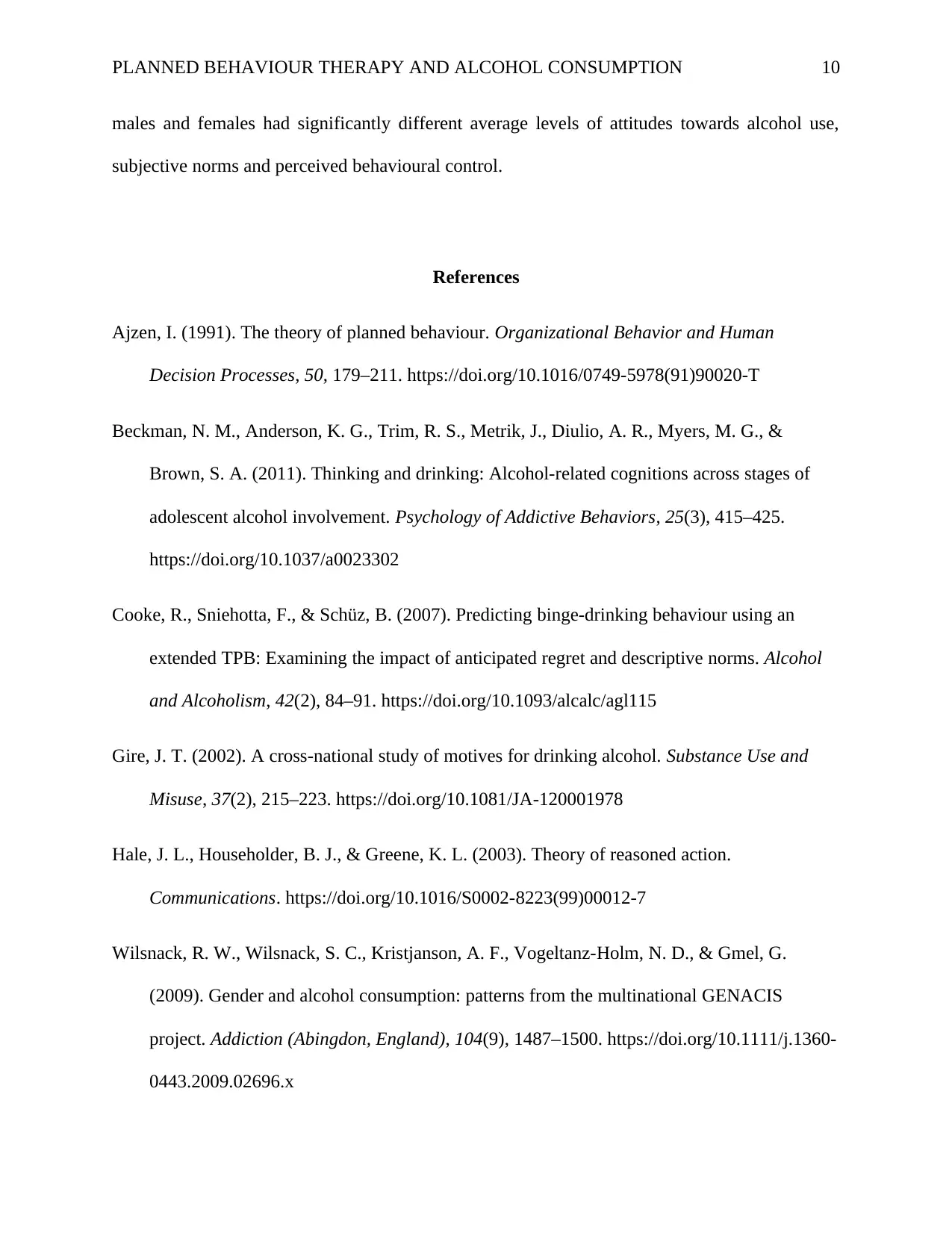
PLANNED BEHAVIOUR THERAPY AND ALCOHOL CONSUMPTION 10
males and females had significantly different average levels of attitudes towards alcohol use,
subjective norms and perceived behavioural control.
References
Ajzen, I. (1991). The theory of planned behaviour. Organizational Behavior and Human
Decision Processes, 50, 179–211. https://doi.org/10.1016/0749-5978(91)90020-T
Beckman, N. M., Anderson, K. G., Trim, R. S., Metrik, J., Diulio, A. R., Myers, M. G., &
Brown, S. A. (2011). Thinking and drinking: Alcohol-related cognitions across stages of
adolescent alcohol involvement. Psychology of Addictive Behaviors, 25(3), 415–425.
https://doi.org/10.1037/a0023302
Cooke, R., Sniehotta, F., & Schüz, B. (2007). Predicting binge-drinking behaviour using an
extended TPB: Examining the impact of anticipated regret and descriptive norms. Alcohol
and Alcoholism, 42(2), 84–91. https://doi.org/10.1093/alcalc/agl115
Gire, J. T. (2002). A cross-national study of motives for drinking alcohol. Substance Use and
Misuse, 37(2), 215–223. https://doi.org/10.1081/JA-120001978
Hale, J. L., Householder, B. J., & Greene, K. L. (2003). Theory of reasoned action.
Communications. https://doi.org/10.1016/S0002-8223(99)00012-7
Wilsnack, R. W., Wilsnack, S. C., Kristjanson, A. F., Vogeltanz-Holm, N. D., & Gmel, G.
(2009). Gender and alcohol consumption: patterns from the multinational GENACIS
project. Addiction (Abingdon, England), 104(9), 1487–1500. https://doi.org/10.1111/j.1360-
0443.2009.02696.x
males and females had significantly different average levels of attitudes towards alcohol use,
subjective norms and perceived behavioural control.
References
Ajzen, I. (1991). The theory of planned behaviour. Organizational Behavior and Human
Decision Processes, 50, 179–211. https://doi.org/10.1016/0749-5978(91)90020-T
Beckman, N. M., Anderson, K. G., Trim, R. S., Metrik, J., Diulio, A. R., Myers, M. G., &
Brown, S. A. (2011). Thinking and drinking: Alcohol-related cognitions across stages of
adolescent alcohol involvement. Psychology of Addictive Behaviors, 25(3), 415–425.
https://doi.org/10.1037/a0023302
Cooke, R., Sniehotta, F., & Schüz, B. (2007). Predicting binge-drinking behaviour using an
extended TPB: Examining the impact of anticipated regret and descriptive norms. Alcohol
and Alcoholism, 42(2), 84–91. https://doi.org/10.1093/alcalc/agl115
Gire, J. T. (2002). A cross-national study of motives for drinking alcohol. Substance Use and
Misuse, 37(2), 215–223. https://doi.org/10.1081/JA-120001978
Hale, J. L., Householder, B. J., & Greene, K. L. (2003). Theory of reasoned action.
Communications. https://doi.org/10.1016/S0002-8223(99)00012-7
Wilsnack, R. W., Wilsnack, S. C., Kristjanson, A. F., Vogeltanz-Holm, N. D., & Gmel, G.
(2009). Gender and alcohol consumption: patterns from the multinational GENACIS
project. Addiction (Abingdon, England), 104(9), 1487–1500. https://doi.org/10.1111/j.1360-
0443.2009.02696.x
1 out of 10
Related Documents
Your All-in-One AI-Powered Toolkit for Academic Success.
+13062052269
info@desklib.com
Available 24*7 on WhatsApp / Email
![[object Object]](/_next/static/media/star-bottom.7253800d.svg)
Unlock your academic potential
Copyright © 2020–2025 A2Z Services. All Rights Reserved. Developed and managed by ZUCOL.





